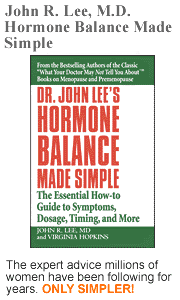|
|
||||
|
For suggestions on how to find a doctor in your area, please go to:  |
||||
|
Heart Disease in Women: Anti-Atherogenic Effects Of Progesterone |
||||
by John R. Lee, M.D. Atherogenesis is the underlying cause of not only coronary artery disease but of arterial disease throughout the body. It is seen as cholesterol plaque within arteries, and we call it atherosclerosis. Female sex hormones exert a protective effect against atherosclerosis. Women prior to menopause are at a much lower risk (ratio 1:10) of cardiovascular disease than men of the same age. After menopause, a woman's cardiovascular disease risk increases until it becomes the main cause of death by about age 60. Total mortality from cardiovascular disease in women eventually almost equals that of men. To understand how this happens, it is important to understand atherogenesis. The connection of serum cholesterol to atherosclerosis is a bit more complicated than generally realized. The idea that cholesterol merely accumulates like sludge in a river is a gross oversimplification. The fact that serum cholesterol levels in postmenopausal women decrease when estrogen is given has led to the assumption that estrogen protects against heart attacks. However, the Framingham study finds that heart attack incidence in postmenopausal women on ERT is no different than women not on ERT. Also, a randomized trial of estrogen plus medroxyprogesterone acetate (Provera) found no prevention of coronary heart disease in postmenopausal women compared to placebo 1 . Something is wrong with the estrogen hypothesis concerning atherosclerosis. Progesterone has been overlooked. Atherogenesis begins in the middle layer of the arterial wall. It is here that oxidized low-density lipoprotein (LDL-cholesterol) is ingested and recycled by lysosomal hydrolysis in macrophages into cytoplasmic cholesteryl ester (CE). Excessive accumulation of CE in macrophages yields the rounded, lipid-filled foam cells that constitute a crucial early step of atherogenesis. Masses of foam cells filling the middle layer of the arteries cause the intimal endothelial lining cells to bulge up into the lumen. Inflammatory erosion of the intima results in the serum cholesterol and fibrin that constitute the plaques seen on the inner surface of atherosclerotic arteries. A recent study 2 at the State University of New York at Stony Brook, NY, using in vitro cell culture, finds that progesterone inhibits the change of cholesterol into CE and decreases CE macrophage cellular levels, thus decreasing foam cell creation. This inhibition of CE by progesterone was (1) reversed by removing the progesterone, and (2) independent of progesterone receptors. Further, the mechanism of action exhibited specific structural requirements, meaning that synthetic progestins are not effective. Also, estradiol, in contrast to progesterone, demonstrated no CE inhibition. Progesterone's effect on glucocorticoid enhancement of CE accumulation in human macrophages was also studied. Glucocorticoid enhancement of CE accumulation occurs with either endogenous cortisol or synthetic glucocorticoids, such as prednisolone and dexamethasone. Progesterone, added during glucocorticoid treatment, blocked this increase of CE accumulation in macrophages. This effect of progesterone was found to be due to prevention of glucocorticoid-induced increases in expression and activity of the gene, acyl-CoA-cholesterol:acyl transferase (ACAT). Unlike its inhibition of CE synthesis macrophages described above, progesterone's inhibition of glucocorticoid enhancement of CE accumulation is nullified by blocking its receptor. Here, again, progestins act to block the beneficial effect of progesterone. These findings help explain not only why chronic stress increases atherosclerosis risk, but also how the proatherogenic action of glucocorticoids could be independent of changes in plasma lipids and may not be prevented by controlling plasma cholesterol. Antagonism by progesterone of glucocorticoid effects on macrophage lipid synthesis is an important step in protecting against the risk of atherosclerosis and, specifically, coronary disease. Summary
Addendum Studies by Hermsmeyer and colleagues at the Oregon Regional Primate Research Center show that Premarin plus progesterone, but not Premarin plus medroxyprogesterone acetate (Provera), protects against coronary artery spasm3. Conclusion Progesterone is not only antiatherogenic but also protects against coronary artery spasm. Progesterone supplementation after menopause is far more effective in preventing coronary heart disease and heart disease deaths than is estrogen alone or estrogen plus progestin. References: 1. Hulley S, Grady D, Bush T, Furberg C, et al. Randomized trial of estrogen plus progestin for secondary prevention of coronary heart disease in postmenopausal women. JAMA 1998; 280: 605-613. 2. Cheng W, Lau OD, & Abumrad NA. Two antiatherogeneic effects of progesterone on human macrophages; inhibition of cholesteryl ester synthesis and block of its enhancement by glucocorticoids. J Clin Endo and Metab 1999; 64: 265-271. 3. Miyagawa K, Rosch J, Stanczyk F, & Hermsmeyer K. Medroxyprogesterone acetate interferes with ovarian steroid protection against coronary vasospasm. Nature Medicine 1997; 3: 324-327.
|
||||




